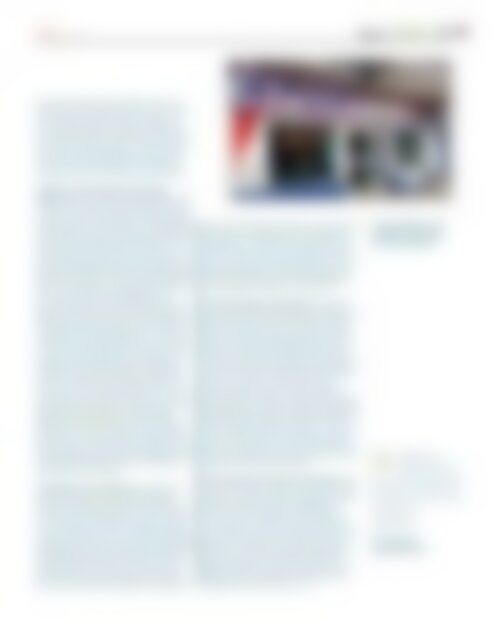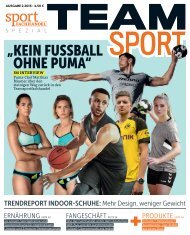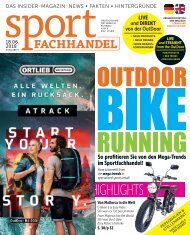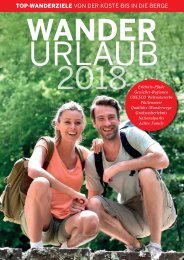sportFACHHANDEL 03_2018 Leseprobe
- Keine Tags gefunden...
Erfolgreiche ePaper selbst erstellen
Machen Sie aus Ihren PDF Publikationen ein blätterbares Flipbook mit unserer einzigartigen Google optimierten e-Paper Software.
3.<strong>2018</strong> Stores<br />
Stores | RETAIL | 49<br />
opened two shops at the new address. Later, the<br />
two became one. Mr Forkl junior recounts, “In this<br />
shop, we had an old pair of skis at the wall from<br />
the 1930s, but we did not sell them.“ Tradition is a<br />
very important factor for the family and one thing<br />
was clear for the Berlin people – if you need sports<br />
equipment, you go to the Skihütte. This was also<br />
true in the times of West Berlin, after the brutal<br />
separation of the city after the Second World War.<br />
In 1980, a fire destroyed the store almost<br />
entirely. “After this tragedy, my grandfather lost the<br />
interest in the business and moved to South Germany<br />
in the region of the Tegernsee where he managed<br />
a sports store too,“ Lars Forkl tells us. “My father took<br />
over the Berlin shop and I have learned the business<br />
there right from the beginning.“ The shop ran very<br />
well, the name attracted customers and the location<br />
at the Bahnhof Zoo (train station Zoo) was great. At<br />
that time, the Skihütte had about 800 square metres<br />
spread over three floors. It was not only comfortable;<br />
there was, for example, a wooden gallery. Even back<br />
then, the store offered a shopping experience,<br />
because winter sports, first of all skiing, were very<br />
popular in Berlin at those times. The typical Berlin<br />
winter sports enthusiast used to travel to the Harz or<br />
to the Alps and it was possible to go cross-country<br />
skiing in the Grunewald, a big forest in the south of<br />
the city. “We had the highest sales in winter, but the<br />
summer business was good too. Inline skates, for<br />
example, were strongly demanded.“ According to<br />
Lars Forkl, the sales considerably increased in the<br />
1990s, due to the German reunification. However,<br />
the rents were also increasing. Above that, a lot of<br />
new sports stores opened in the eastern part of Berlin<br />
and attracted the customers. In 1999, the sports<br />
goods dealer Jürgen Merker acquired the shop.<br />
“My father was sad that I didn’t want to manage the<br />
business, but it was just too hard for me then,“ Mr<br />
Forkl explained. “We had almost 40 employees then.<br />
I rather wanted a smaller shop, although I think that<br />
the shop would still exist.“ However, hindsight is<br />
always easier than foresight.<br />
A hard blow was, nevertheless, that the department<br />
store chain Karstadt opened the biggest<br />
sports shop of Europe directly on the other side of<br />
the street in the listed Bilka House in 1995. “We lost<br />
a lot of customers to the giant competitor and they<br />
even stole salespersons of us.“ The famous Skihütte<br />
at this location is history today. Even industry expert<br />
Jürgen Marker had to give up in the end, despite the<br />
new beginning and a relocation. Many customers<br />
remember the name Forkl. In the year 2000, Lars<br />
Forkl opened his own shop under the name Sportdiscount,<br />
unfortunately not Skihütte. He said happily,<br />
“A lot of customers know who we are and where<br />
we come from.“ Nevertheless, the circumstances<br />
are difficult. The traditional sports goods retailer is<br />
still focussed on virtues such as competent advice<br />
and service and has strong competition from sports<br />
chains and web dealers. Often customers come to<br />
him from other shops, since they are disappointed.<br />
“I hear that again and again,“ he pointed out.<br />
Lars Forkl is known in his quarter. The regular<br />
customers appreciate his know-how and efforts. The<br />
boss works in the shop himself. He does no longer<br />
offer winter hardware, but a vast range of apparel<br />
instead. Forkl found and defined his own area. This<br />
involves team sports, flocking and textile print as<br />
well as the creation of own designs. He underlines,<br />
“I make very individual things which other retailers<br />
do not offer. They are only interested in quantities.<br />
Once, my concept was: I have to find a niche<br />
between a department store and the traditional<br />
retail business of my father.“ Mr Forkl is able to offer<br />
high-quality items, since he purchases economically.<br />
For example also sneakers and apparel from the last<br />
season still demanded by the customers. “This is a<br />
way to stand out from the competition as well; and,<br />
of course, competent service. It is sad that there are<br />
less and less specialised sports shops and that we are<br />
losing the individuality,“ he affirms.<br />
The revenue share of shoes has increased to app<br />
70 percent; the rest are clothes. “It was the contrary<br />
in the past. I sold more winter apparel and ski pants,<br />
but these categories have lost in significance.“<br />
His secret now is: offering an interesting mix of<br />
current products and stocks. His shop is the only<br />
one which has certain trend sneakers. Forkl handles<br />
the purchase himself or gets it directly from the<br />
producers. “You have to be flexible and know what<br />
the customers want and meet their needs.“ His<br />
biggest advantage is: specialised knowledge about<br />
all kind of sports. He finishes, “Luckily , I am not<br />
organised in a buying association.“
















